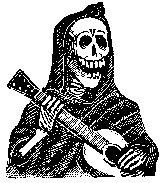The “Corrido de Kiansis” and the Ballad Tradition of the Lower Border

Picture by José Posada, taken from Monografia (see works cited)
The Texas cattle industry of the 1860s was ultimately a confluence of Anlgo and Mexican ranching style and technology. The mergence of Anglo and Mexican economies caused racial tensions. In their desire for more land, Anglo ranchers drove Tejanos off what had orginally been Mexico, and what they saw as their land. In this way, the cattle industry, which was an economic and social importance in Texas for both Tejanos and Anglos was a direct cause of intercultural conflict. Forced to convert from their agrarian society to an industrial economy, the Vaquero, as well as all Tejanos, had to adapt to the “formidable mechanism” of the ranching economy that worked to keep them in a subjugated economic position (Alonzo, 57).
During the 1840's the cattle industry in the Coastal Plains of Texas was run by Anglo ranchers that still practiced European ranching techniques. With westward expansion of the Untied States, Anglo ranching styles merged with many long-standing traditions of Mexican cattle ranching. Since the 1850's the vaquero had replaced slave labor as the typical ranch hand (Jordan, 83). The stratification of labor on the ranches put Tejanos in a position of inferiority to the white land owners and were paid very low wages. Nevertheless the vaquero, or Mexican cowboy, saw himself as having superior skills that were vital to the survival of the ranching industry. Vaqueros were highly skilled horsemen, characterized as men of great bravery and comradery. They brought with them the knowledge of Mexican ranching, which were the roots of the success of the South Texas ranching industry. They brought Mexican ranching techniques and technology including chaparreras, boots, whips, lassoes, and sombreros. Although the vaquero was aware of his exploitation they were the ones who were truly in control of cattle on the ranch and on the trail, not the Anglo authority figures (De León, 57). This reversal in status is expressed in the "Corrido de Kiansis." This “role reversal” is characteristic of the larger Border Corrido tradition, when the brave Mexicano is in the position of authority over Anglos. Although the "Corrido de Kiansis" is one of the most early, this role reversal seen in later corridos such as El Corrido de Gregorio Cortez, where Cortez defies Anglo law enforcers, who are portrayed as cowardly and scared of “un sólo Mexicano” (only one Mexican) (Paredes, A Texas-Mexican Cancionero, 65).
This power
struggle between the Anglo and the Tejano is exemplary of the greater struggle
of the Tejano during this epoch in Chicano history. Anglo ranching displaced
many Tejano families who saw it as their homeland. The ranching industry
in many ways was a cause of the growth of intercultural conflict. It represented
economic dominance, Anglo ethnocentricty and disregard for any Mexican claim
to the land. This heroic vaquero figure for this reason is very important
as an assertion of national and cultural importance in the South Texas and
border area. In the corrido, the vaquero is seen as a symbol of cultural
pride and strength, in contrast to the ineptitude of the Anlgo in respect
to skill on the range. The "Corrido de Kiansis" is a reassertion
of the Tejano contribution to the success of the cattle industry.